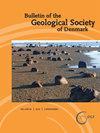格陵兰东部Kangerlussuaq的Kærven正长岩杂岩形成过程中原位结晶和间隙熔体损失的重要性
IF 1
4区 地球科学
Q2 Earth and Planetary Sciences
引用次数: 0
摘要
Kærven正长岩杂岩(KSC)是第三纪东格陵兰省最古老的长英质侵入岩之一。在这里,我们更新了以前对KSC的描述,并提供了一个大大扩展和全面的地球化学数据集。新的数据使我们能够为KSC的演化提供更详细的岩石成因模型,并研究损失和偶尔替换残余液体的火成岩堆积的地球化学特征。KSC由11个可映射的单元组成,通常向西。岩石类型从石英正长岩到石英碱长石正长岩和碱长石花岗岩。单个侵入单元相对狭窄,侧面陡峭,总体上代表一个环形岩脉复合体。基岩片麻岩和辉长岩寄主局部污染了最古老的石英正长岩KSC单元,但大部分杂岩主体未受寄主影响。晚期一套东西向北东向南南向的粗砂质至声母岩组成的过碱性岩脉侵入KSC。KSC岩石的SiO2含量在59 - 73%之间,范围相当大。对于给定的SiO2,几种元素的浓度变化很大(特别是在SiO2 < 66 wt%时),而变化图并没有为络合物单元的演化提供一个单一的模型。设想了几个KSC单位的累积起源。地球化学模型表明,KSC岩浆来源于不止一个原始岩浆,并且该复合体的演化经历了四个阶段:在前兆岩浆房中部分结晶,随后是每个岩浆单元的最终就位,建立晶体/熔体,排出部分残余熔体,最后是剩余熔体的结晶。在两个密切相关的石英碱长石正长岩单元中,碱长石与寄主岩之间的微量元素不平衡表明,高演化的残余熔体被低演化的熔融相所取代。对Kærven岩浆的潜在母体熔体成分的模拟表明,其起源不是冰岛羽流软流圈,而是一个中等富集的来源,可能在大陆岩石圈中。通过部分结晶作用的熔体演化过程发生在深部岩浆房中,岩浆反复上升到上部地壳岩浆房中并在那里结晶形成了KSC。根据已发表的地球化学资料,推断出的母岩浆似乎在北大西洋火成岩省几乎没有等同物,可能主要是由可能是太古宙时代的富集干燥岩石圈地幔熔融产生的。本文章由计算机程序翻译,如有差异,请以英文原文为准。
The importance of in situ crystallisation and loss of interstitial melt during formation of the Kærven Syenite Complex, Kangerlussuaq, East Greenland
The Kærven Syenite Complex (KSC) is one of the oldest felsic intrusions in the Tertiary East Greenland province. Here we update our previous description of the KSC and supply a greatly expanded and comprehensive geochemical dataset. New data allow us to present a more detailed petrogenetic model for the evolution of the KSC and to investigate the geochemical characteristics of igneous cumulates subjected to loss and, occasionally, replacement of residual liquid. The KSC comprises eleven mappable units that generally young westwards. Rock types range from quartz syenite to quartz alkali feldspar syenite and alkali feldspar granite. Individual intrusive units are relatively narrow and steep-sided and are collectively suggested to represent a ring dyke complex. Basement gneiss and gabbro host rocks have locally contaminated the oldest quartz syenite KSC unit, but most of the main part of the complex escaped significant influence from host rocks. A late suite of E–W to NE–SW striking peralkaline dykes of trachytic to phonolitic compositions intrude the KSC. Compositions of the KSC rocks span a considerable range in SiO2, 59–73 wt%. Concentrations of several elements vary widely for a given SiO2 (especially at SiO2 < 66 wt%), and variation diagrams do not suggest a single model for the evolution of the units of the complex. A cumulative origin is envisaged for several KSC units. Geochemical modelling suggests that KSC magmas were derived from more than one primary magma, and that the complex evolved through a four-stage process: fractional crystallisation in precursory magma chambers was followed by final emplacement of each unit, establishment of a crystal/melt mush, expulsion of part of the residual melt and, finally, crystallisation of the remaining melt. Trace element disequilibria between alkali feldspar and host rocks in two closely associated quartz alkali feldspar syenite units indicate that highly evolved residual melt was replaced by a less evolved melt phase. Modelling of potential parent melt compositions to the Kærven magmas suggests an origin not in the Iceland plume asthenosphere, but rather in a moderately enriched source, possibly in the continental lithosphere. The course of melt evolution by fractional crystallisation is indicated to have taken place in magma chambers at depth, and repeated rise of magma into the upper crustal magma chambers and crystallisation there formed the KSC. Based on our survey of published geochemical data, the inferred parental magmas seem to have few equivalents in the North Atlantic Igneous Province and may have been generated mainly from melting of enriched dry lithospheric mantle of possibly Archaean age.
求助全文
通过发布文献求助,成功后即可免费获取论文全文。
去求助
来源期刊

Bulletin of the Geological Society of Denmark
GEOSCIENCES, MULTIDISCIPLINARY-
CiteScore
2.80
自引率
16.70%
发文量
28
审稿时长
>12 weeks
期刊介绍:
The Bulletin publishes contributions of international interest in all fields of geological sciences on results of new work on material from Denmark, the Faroes and Greenland. Contributions based on other material may also be submitted to the Bulletin if the subject is of relevance for the geology of the area of primary interest.
 求助内容:
求助内容: 应助结果提醒方式:
应助结果提醒方式:


